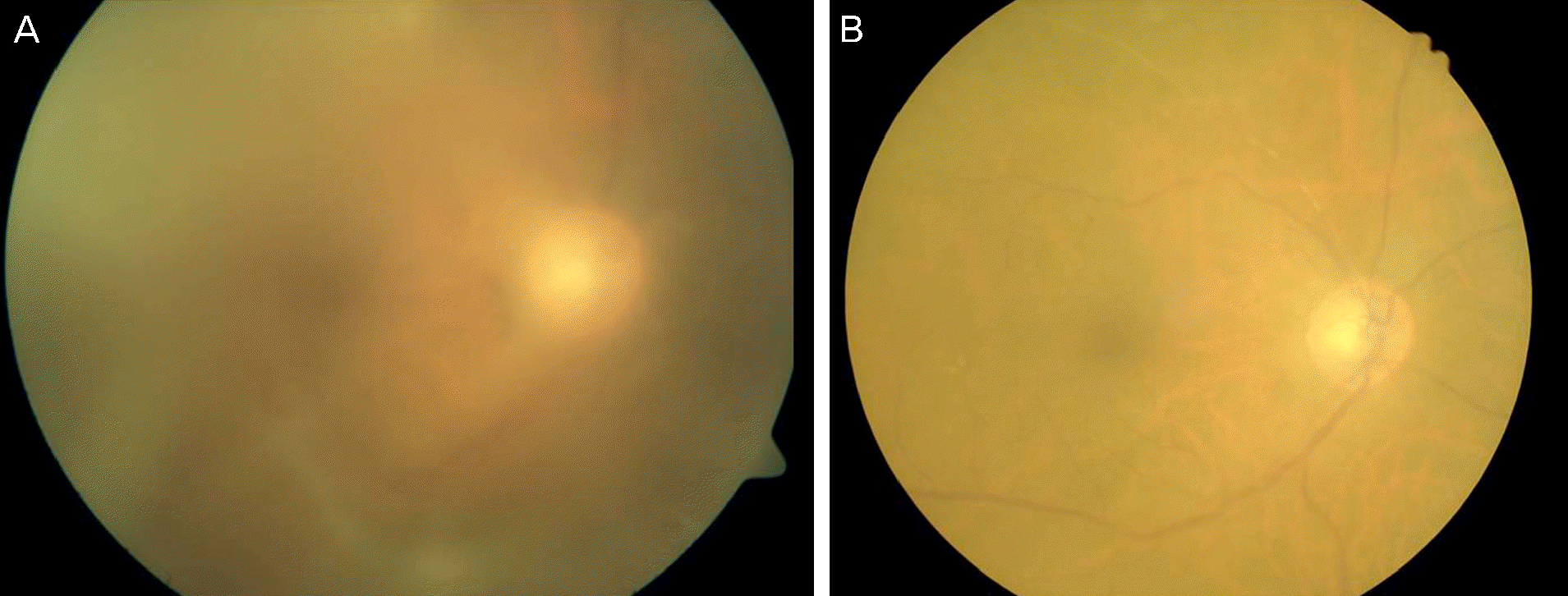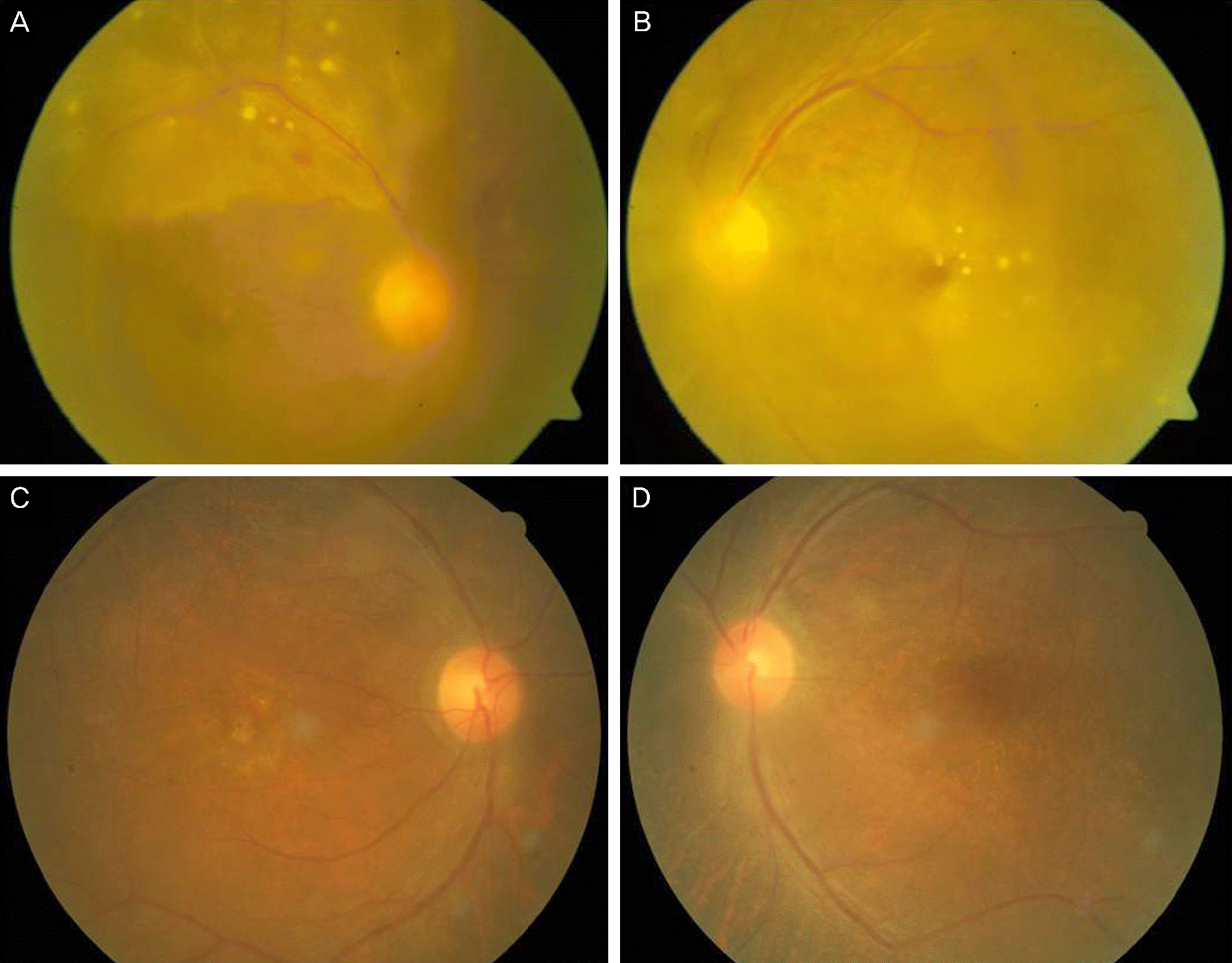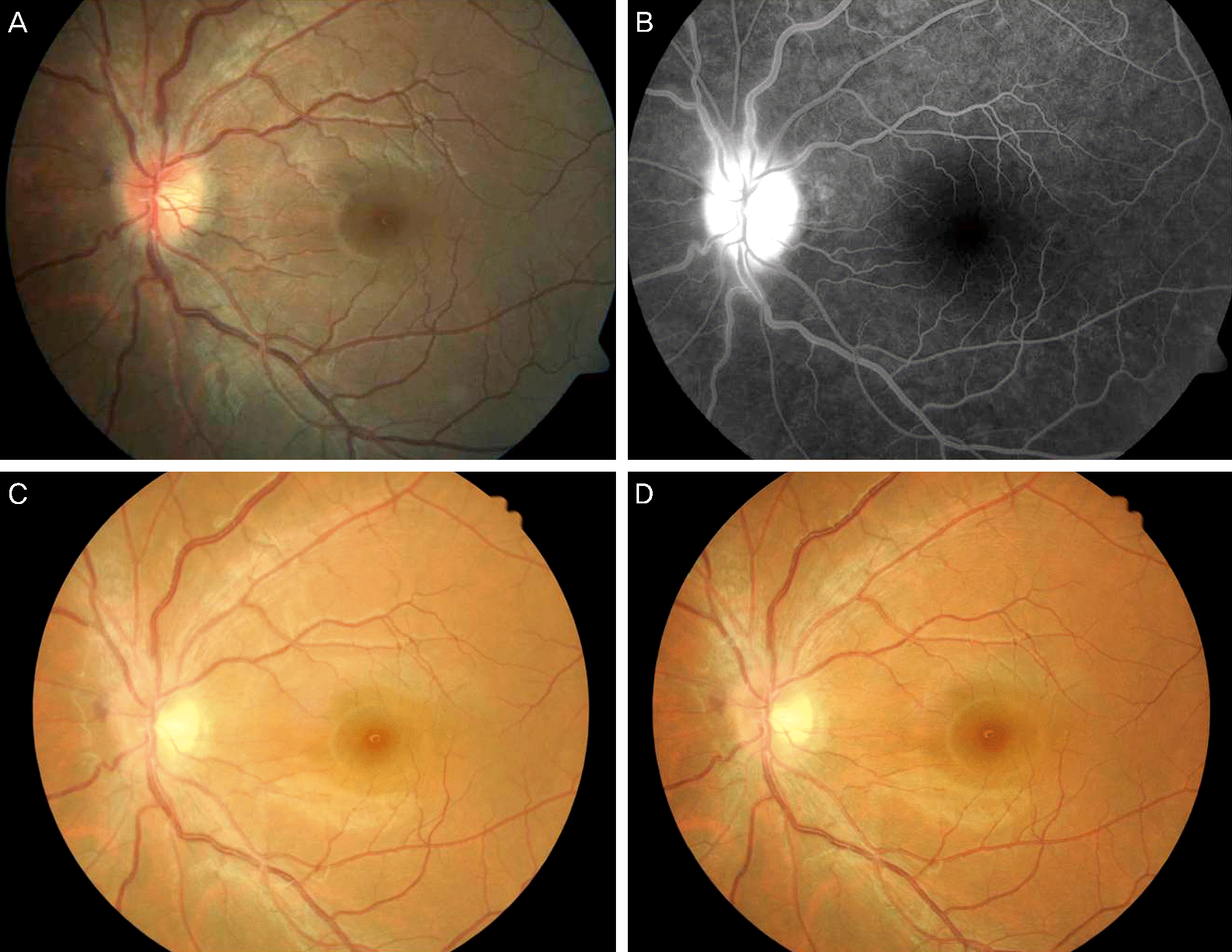Abstract
Purpose
In recent, years, an increase of syphilis infections has become an issue in Korea as well as globally. Herein, we report a recent clinical manifestation of syphilitic uveitis in a Korean population.
Methods
Over a 5-year period (2007-2012), we collected and analyzed the medical records of 16 patients with syphilitic uveitis in three tertiary eye clinics in Pusan. Sixteen patients were confirmed to have syphilis based on serological tests. Retrospective chart review was performed to determine the best corrected visual acuity, anterior and posterior segments, and treatment regimen, as well as ancillary test results including fluorescein angiogram (FAG).
Results
Of the 16 patients, 12 were males and four were females. The mean age of the patients was 51.16 years. Non-gran-ulomatous anterior uveitis was observed in nine eyes (47.4%). Vitritis was the most frequently observed posterior segment finding (16 eyes, 84.2%). Retinal vasculitis and chorioretinitis were found in 11 (57.9%) and five eyes (26.3%), respectively. All patients had negative results in the serum HIV antibody test. Of the 16 patients, 15 were treated with penicillin or ceftriaxone due to neurosyphilis. Mean visual acuity improved from 1.33 ± 1.1 to 0.58 ± 0.68 after treatment.
Conclusions
Clinical manifestation of syphilitic uveitis in Korean patients is different from occurrences in Western countries. Ophthalmological findings of syphilitic uveitis are diverse; thus, serological testing for syphilis is recommended for all uveitis patients. Further research regarding long-term treatment, relapse of syphilitic uveitis, and complications is necessary.
References
1. Goldsmith LA, Katz SI, Gilchrest BA, et al. Fitzpatrick's Dermatology in General Medicine. 8th ed.New York: McGraw-Hill;2008. p. 1955–7.
2. Primary and secondary syphilis--United States, 2003-2004. MMWR Morb Mortal Wkly Rep. 2006; 55:269–73.
3. Herida M, Michel A, Goulet V, et al. Epidemiology of sexually transmitted infections in France. Med Mal Infect. 2005; 35:281–9.
4. Parc CE, Chahed S, Patel SV, Salmon-Ceron D. Manifestations and treatment of ocular syphilis during an epidemic in France. Sex Transm Dis. 2007; 34:553–6.

5. Anshu A, Cheng CL, Chee SP. Syphilitic uveitis: an Asian perspective. Br J Ophthalmol. 2008; 92:594–7.

8. Singh AE, Romanowski B. Syphilis: review with emphasis on clinical, epidemiologic, and some biologic features. Clin Microbiol Rev. 1999; 12:187–209.

9. Foster C. Stephen, Vitale Albert T., Pomerantz , et al. Diagnosis and Treatment of Uveitis. Philadelphia: WB Sounders CO.;2002.
10. Barile GR, Flynn TE. Syphilis exposure in patients with uveitis. Ophthalmology. 1997; 104:1605–9.

12. Drancourt M, Berger P, Terrada C, et al. High prevalence of fastid-ious bacteria in 1520 cases of uveitis of unknown etiology. Medicine (Baltimore). 2008; 87:167–76.

13. Puech C, Gennai S, Pavese P, et al. Ocular manifestations of syphilis: recent cases over a 2.5-year period. Graefes Arch Clin Exp Ophthalmol. 2010; 248:1623–9.

14. Baek JO, Jee HJ, KIm TK, et al. Recent trends of syphilis prevalence in normal population in Korea: a single center study in Seoul. Korean J Dermatol. 2011; 49:106–10.
15. Marra CM. Syphilis and human immunodeficiency virus: prevention and politics. Arch Neurol. 2004; 61:1505–8.
16. Shalaby IA, Dunn JP, Semba RD, Jabs DA. Syphilitic uveitis in human immunodeficiency virus-infected patients. Arch Ophthalmol. 1997; 115:469–73.

17. Tran TH, Cassoux N, Bodaghi B, et al. Syphilitic uveitis in patients infected with human immunodeficiency virus. Graefes Arch Clin Exp Ophthalmol. 2005; 243:863–9.

18. Becerra LI, Ksiazek SM, Savino PJ, et al. Syphilitic uveitis in human immunodeficiency virus-infected and noninfected patients. Ophthalmology. 1989; 96:1727–30.

19. Gass JD, Braunstein RA, Chenoweth RG. Acute syphilitic posterior placoid chorioretinitis. Ophthalmology. 1990; 97:1288–97.

20. Wickremasinghe S, Ling C, Stawell R, et al. Syphilitic punctate in-ner retinitis in immunocompetent gay men. Ophthalmology. 2009; 116:1195–200.

21. Mendelsohn AD, Jampol LM. Syphilitic retinitis. A cause of ne-crotizing retinitis. Retina. 1984; 4:221–4.
23. Shann S, Wilson J. Treatment of neurosyphilis with ceftriaxone. Sex Transm Infect. 2003; 79:415–6.

24. Zhou P, Gu Z, Xu J, et al. A study evaluating ceftriaxone as a treatment agent for primary and secondary syphilis in pregnancy. Sex Transm Dis. 2005; 32:495–8.

25. Steele RW. Ceftriaxone therapy of meningitis and serious infections. Am J Med. 1984; 77:50–3.
26. Marra CM, Boutin P, McArthur JC, et al. A pilot study evaluating ceftriaxone and penicillin G as treatment agents for neurosyphilis in human immunodeficiency virus-infected individuals. Clin Infect Dis. 2000; 30:540–4.

Figure 1.
Syphilitic uveitis. (A) At initial presentation, fundus photograph showed severe vitiritis in right eye. Patient's visual aucity was 0.125 and VDRL titer was 1:128 (B) After treatment with three times of weekly intramuscular penicillin G benza-thine injection, patient visual acuity increased to 0.63 and VDRL titer decreased to 1:2. After 3 months of treatment, fundus photograph showed resolving of vitritis.

Figure 2.
Syphilitic uveitis. (A, B) Fundus photograph showed vitritis, retinal vasculitis and inflammatory retinal infiltration in both eyes. VDRL titer was 1:128 and FTA-ABS test was positive. On CSF examination, increased lymphocyte count and VDRL titer were examined. (C, D) Patient treated with daily 2 gm of intravenous ceftriaxone injection for 2 weeks. At 4 months after treatment, fundus photography showed no evidence of uveitis. FTA-ABS = fluorescent treponemal antibody-absorption; CSF = cerbrospinal fluid.

Figure 3.
Fundus photograph and fluorescein angiography of syphilitic optic neuritis case. Presenting symptoms were decreased visual acuity and pain with ocular movement. (A) At the initial fundus photograph showed mild blurring and swelling of the optic disc margin. There ware no other inflammatory signs such as vasculitis, vitritis and retinitis. (B) Early phase of fluerescein angiography showed fluoresein leakage at the optic disc. At first, patient was misdiagnosised with optic neuritis, but at serologic test, VDRL titer was incread to 1:64 and FTA-ABS as positive. (C) 10 days after penicillin treatment, ocualr pain decreased and in fundus photograph optic disc blurring was decreasd. (D) 21 days after treatment, VDRL titer decreased to 4:1 and there were no blurring of the optic disc margin.

Table 1.
Demographic characteristics of ocular syphilis patient
Table 2.
Ophthalmologic finding of ocular syphilis patient
Table 3.
Comparison of therapeutic regimen and effect
| IM Penicilin (n = 8) | IV penicilin (n = 2) | IV Ceftriaxone (n = 5) | |
|---|---|---|---|
| Dose | 2.4 million IU | 2.0 milion IU | 2 g/day |
| Duration | (once a week 3 times) | 13 days | 14 days |
| Result | |||
| Improved visual acutiy* | 6 (75%) | 2 (100%) | 4 (80%) |
| Decreased VDRL titier† | 8 (100%) | 2 (100%) | 5 (100%) |




 PDF
PDF ePub
ePub Citation
Citation Print
Print


 XML Download
XML Download